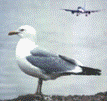Bird Strike Committee Proceedings
Date of this Version
August 2006
Document Type
Article
Abstract
Westover Air Reserve Base (ARB) in western Massachusetts is home to 17 USAF C-5A Galaxy airlifters. The mammoth C-5, with a 222 foot wingspan and length of 247 feet, is the backbone of the U.S. Air Force airlift fleet. The 2,500-acre base is home to the largest single area of grassland in Massachusetts. The BASH program at Westover focuses mainly on the wildlife risk posed to the C-5, and is administered by the 439th Airlift Wing safety office. Airfield grasslands are host to two state-listed endangered/threatened bird species: the Grasshopper Sparrow and the Upland Sandpiper. To protect our airplanes from wildlife strikes, the Bird Hazard Working Group (BHWG) at Westover ARB works closely with state and federal agencies, including the Massachusetts Division of Wildlife Endangered Species Division, the Fish and Wildlife Service Office of the U.S. Department of the Interior and the Wildlife Services Division of the U.S. Department of Agriculture (USDA). We hold a long-standing contract with the latter which includes the services of a full-time wildlife biologist who does outstanding work implementing key facets of our BASH plan. Interagency coordination of this type is essential to managing the risk. The Westover ARB BASH plan employs a classic risk-management process to deal with this risk from every possible angle. Identifying the hazard, for example, is the first important step. Since 1997, the base has compiled detailed historical data on each species involved in a known or suspected bird strike. The data include bird remains discovered on aircraft, taxiways and runways. All are identified by the Smithsonian Institution. With the use of all available expertise as well as careful analysis of our bird strike data, we focus on mitigating the probability of damaging strikes from larger/denser wildlife, such as flocking waterfowl. These larger flocking species are much more likely to result in damage to aircraft than a collision with smaller grassland species. The latter comprise the great majority of our strikes. Risk assessment in our BASH plan requires continual management, varying with migration patterns, weather, and environmental conditions. The BHWG includes a representative from the Operations Group, responsible for flying the aircraft, to constantly assess the bird strike risk. The BHWG evaluates and implements control measures for their simplicity, cost and effectiveness. An example is our base mowing plan, which is designed to minimize risk to the threatened/endangered species without compromising air safety issues. The BHWG decides on appropriate control measures and implements them through the BASH plan. This plan is a fluid document which can be quickly changed in response to a new wildlife threat, such as a nearby landfill expansion. Depredation is the last resort and is managed exclusively by our USDA specialist on base. In summary, the Westover Safety Office secures significant input from all responsible and interested agencies, both on and off base. The BHWG enjoys active participation from the commander, the air traffic control facility, aircrew members, the real property manager, the environmental engineer, aircraft maintenance, state/federal agencies, nearby landfill operators and golf course operators. Managing the bird strike risk from every angle has produced excellent, measurable results that have contributed directly to the safe flying environment at Westover ARB.

